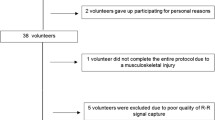Summary
The relationship between the time course of heart rate and venous blood norepinephrine (NE) and epinephrine (E) concentrations was studied in 7 sedentary young men before and during 3 bicycle exercises of 5 min each (respectively 23±2.8%, 45±2.6% and 65±2.4% \(\dot V_{{\text{O}}_{{\text{2 max}}} } \), mean ±SE). During the low level exercise the change in heart rate is monoexponential (τ =5.7±1.2s) and no increment above the resting level of NE (ΔNE) or of E (ΔE) occurs. At the medium and highest intensity of exercise: a) the change in heart rate is biexponential, τ for the fast and the slow component averaging about 3 and 80 s respectively; b) ΔNE (but not ΔE) increases continuously with time of exercise; c) at the 5th min of exercise heart rate increments are related to ΔNE; d) between 20s and 5 min, at corresponding sampling times, the heart rate of the slow component is linearly related to ΔNE. At exercise levels higher than 33% \(\dot V_{{\text{O}}_{{\text{2 max}}} } \) the increase in heart rate described by the slow component of the biexponential kinetic could be due to an augmented sympathetic activity revealed by increased NE blood levels.
Similar content being viewed by others
References
Åstrand PO, Rodahl K (1986) Textbook of work physiology. McGraw Hill Co, New York, pp 299, 359–360
Beck W, Barnard CN, Schrire V (1969) Heart rate after cardiac transplantation. Circulation XL:437–445
Bertel O, Buhler FR, Kiowskj W, Lutold BE (1980) Decreased beta-adrenoreceptor responsivness as related to age, blood pressure and plasma catecholamines in patients with essential hypertension. Hypertension 2:130–138
Broman S, Wigertz O (1971) Transient dynamics of ventilation and heart rate with step changes in work load from different load levels. Acta Physiol Scand 81:54–74
Christensen NJ, Brandsborg O (1973) The relationship between plasma catecholamine concentration and pulse rate during exercise and standing. Eur J Clin Invest 3:299–306
Christensen NJ, Galbo H (1983) Sympathetic nervous activity during exercise. Ann Rev Physiol 45:139–153
Davies CTM, Few J, Foster KG, Sargeant AJ (1974) Plasma catecholamine concentration during dynamic exercise involving different muscle groups. Eur J Appl Physiol 32:195–206
Dixon WJ (1983) BMDP Statistical Software. Univ of California Press, Berkeley, p 672
Donald DE (1968) Capacity for exercise after denervation of the heart. Circulation XXXVIII:225–226
Escourrou P, Johnson DG, Rowell LB (1984) Hypoxemia increases plasma catecholamine concentrations in exercising humans. J Appl Physiol 57:1507–1511
Folkow B, DiBona GF, Hjemdhal P, Thoren PH, Wallin BG (1983) Measurements of plasma norepinephrine concentration in human primary hypertension. A word of caution on their applicability for assessing neurogenic contributions. Hypertension 5:86–89
Galbo H (1983) Hormonal and metabolic adaptation to exercise. Thieme, Stuttgart, pp 2–27
Goldstein DS, Feuerstein G, Izzo JL, Opire U, Keiser HR (1981) Validity and reliability of liquid chromatography with electrochemical detection for measuring plasma levels of norepinephrine and epinephrine in man. Life Sci 28:467–475
Hughson RL, Morrissey MA (1983) Delayed kinetics of \(\dot V_{{\text{O}}_{\text{2}} } \) in the transition from prior exercise. Evidence for O2 transport limitation of 650-02 kinetics: a review. Int J Sports Med 4:31–39
Kendall M, Stuart A, Ord JK (1983) The advanced theory of statistics. Griffin and Co Ltd, London and High Wycombe
Kniffy KD, Mense S, Schmidt RF (1981) Muscle receptors with fine afferent fibers which may evoke circulatory reflexes. Circ Res [Suppl I] 48:25–31
Linnarson D (1974) Dynamics of pulmonary gas exchange and heart rate changes at start and end of exercise. Acta Physiol Scand [Suppl] 415:1–68
Lewis SF, Snell PG, Taylor WF, Hamra M, Graham RM, Pettinger WA, Blomqvist GC (1985) Role of muscle mass and mode of contraction in circulatory responses to exercise. J Appl Physiol 58:146–151
Mense S, Stahnke M (1983) Responses in muscle afferent fibers of slow conduction velocity to contractions and ischaemia in the cat. J Physiol 342:383–397
Mitchell JH, Kaufman ML, Iwamoto GA (1983) The exercise pressor reflex: its cardiovascular effects, afferent mechanism, and central pathways. Ann Rev Physiol 45:229–242
Orizio C, Comande S, Margonato V, Veicsteinas A (1983) Kinetics of heart rate increase with exercise in different athletes. IRCS Med Sci 11:329–330
Robinson BF, Epstein SE, Beiser GD, Braunwald E (1966) Control of heart rate by the autonomic nervous system. Circ Res 19:400–411
Rybicki KJ, Waldrop TG, Kaufman MP (1985) Increasing gracilis muscle interstitial potassium concentrations stimulate group III and IV afferents. J Appl Physiol 58:936–941
Wallin BG, Morlin C, Hjemdahl P (1987) Muscle sympathetic activity and venous plasma noradrenaline concentrations during static exercise in normotensive and hypertensive subjects. Acta Physiol Scand 129:489–497
Zucker IH, Gilmore JP (1985) Aspects of cardiovascular reflex in pathologic states. Fed Proc 44:2400–2407
Author information
Authors and Affiliations
Rights and permissions
About this article
Cite this article
Orizio, C., Perini, R., Comandè, A. et al. Plasma catecholamines and heart rate at the beginning of muscular exercise in man. Europ. J. Appl. Physiol. 57, 644–651 (1988). https://doi.org/10.1007/BF00418477
Accepted:
Issue Date:
DOI: https://doi.org/10.1007/BF00418477




